Sasadre is a born performer. The energetic septuagenarian from the Aboriginal Paiwan community dandyishly presents himself with a scarf tastefully tied around his neck and a laurel adorning his crown — made from a plant I’m too distracted by his schtick to ask the name of. We are in the mountains of Taitung County, and Sasadre has been tasked to teach us about his community’s traditional slate houses and agricultural practices. He does so with panache.
For the 60 minutes we are at the settlement, Sasadre variously scolds our party for using a hunter’s knife incorrectly, encourages us to dig up peanuts, instructs us on the proper way to scare birds with tin cans and gifts us amulets. While in a field perpendicular to the house, he comically berates a photographer for stamping through his sweet potato plants. As a light rain begins to fall, he redirects us back to the slate house.
“You are all getting away without doing any real work today,” he quips in Mandarin, feigning disappointment that the weaved baskets he had handed out earlier are returning empty.
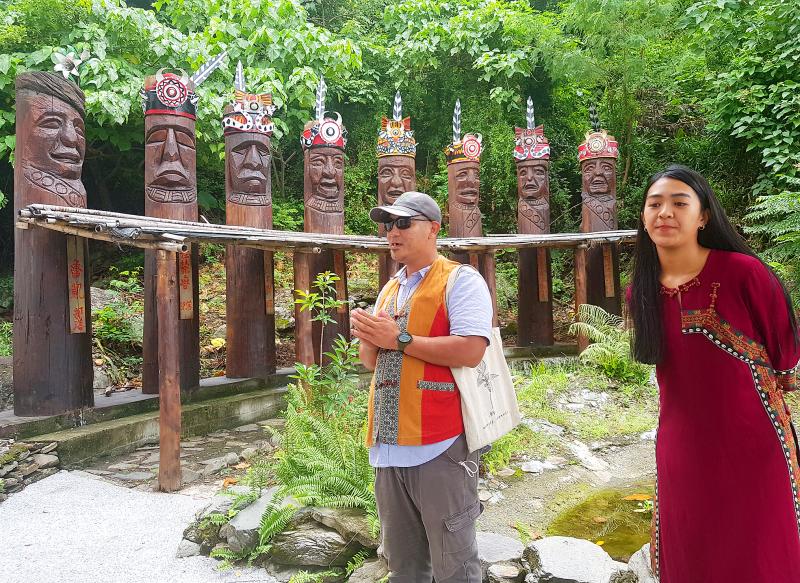
Photo: Noah Buchan, Taipei Times
Perimetering the back of the slate house is a low stone wall, now wet and slippery, and as Sasadre helps us over it and onto the compound proper, he offers the women a large leaf picked from a taro plant that abuts the wall.
“It’s an umbrella,” he exclaims, and picks one for himself.
Moments later, back in the semi-darkness of the slate house, Sasadre discusses the uses of millet and Formosan quinoa drying within, all while continuing to hold the “umbrella” over his head, his calloused fingers dancing it back and forth with every point. I couldn’t get enough.
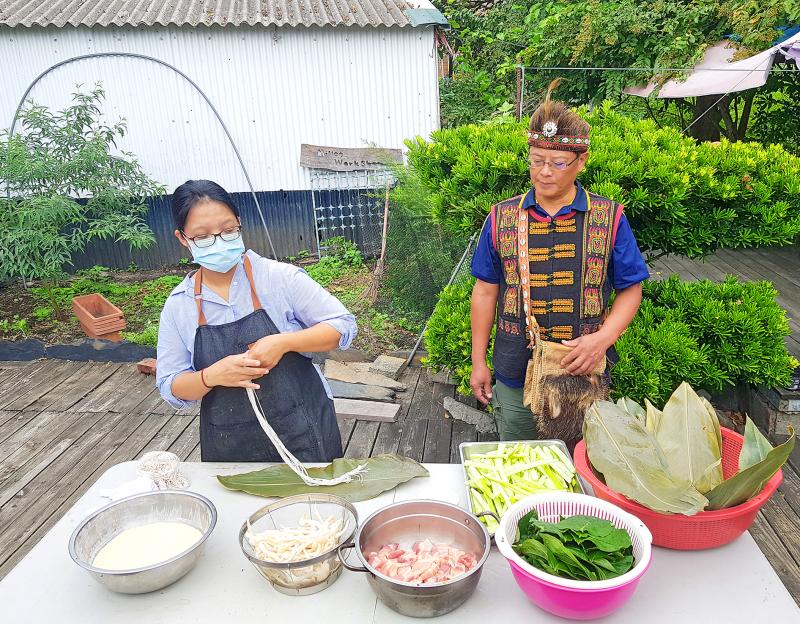
Photo: Noah Buchan, Taipei Times
Sasadre’s intoxicating antics and expositions of his community’s traditions, think of it as a cross between vaudeville and Max Weber, were part of 2020 Cross-Generational Bilingual Training Program, a four-year project spearheaded by the Taitung County Government. The aim of the project is to develop DIY workshops and walking tours led by English-language guides from Aboriginal communities — there are 16 recognized indigenous peoples in Taiwan — to introduce, for example, how to make Paiwan dumplings with millet paste or elucidate an Amis community’s provenance. We are here to see the fruits of the project’s first year.
“People are looking for niche-based ... [and] community-based tourism that doesn’t exploit [Aboriginal] communities,” says Cheryl Robbins, a three-decade resident of Taiwan who is assisting on the project.
NICHE TOURISM
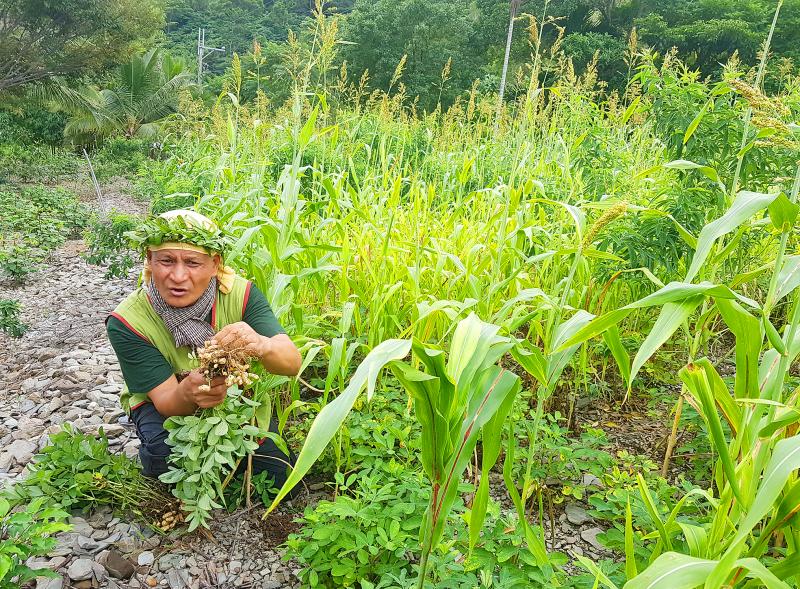
Photo: Noah Buchan, Taipei Times
Taiwan’s Tourism Bureau has for years promoted tourism to Aboriginal communities by shipping in bus loads of tourists as though they are visiting a theme park, rather than an opportunity to gain a deeper understanding for their rituals and culture.
In a July 2015 Taipei Times report, Kakimi of the Katratripulr community said that tourists often consume their rituals and festivals like commodities, asking questions like: “How come you haven’t started dancing?” “Why don’t you sing for us?” and “What are you guys eating, can we have some, too?”
So annoyed had Aboriginal communities become, they gave the Tourism Bureau a taste of their own medicine and formed their own “tour” in July 2014 at its headquarters in Taipei.
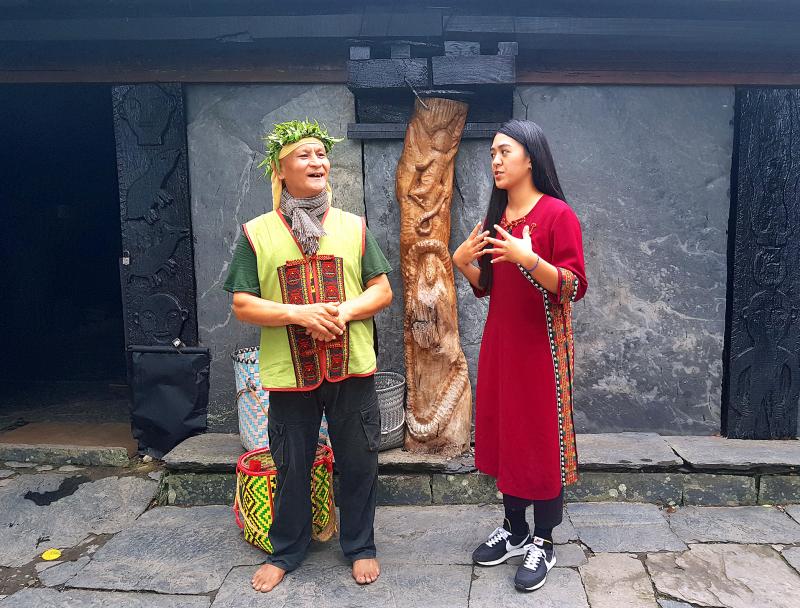
Photo: Noah Buchan, Taipei Times
“Now, everyone, let’s take a look over there. You can see the staff are performing the act of working,” said “tour guide” Namoh Nofu, an Aboriginal rights activist, pointing to employees behind a glass door.
A “sightseer” noted the interesting clothing worn by the civil servants.
“But where is your buttoned Mandarin jacket?” the “tourist” remarked.
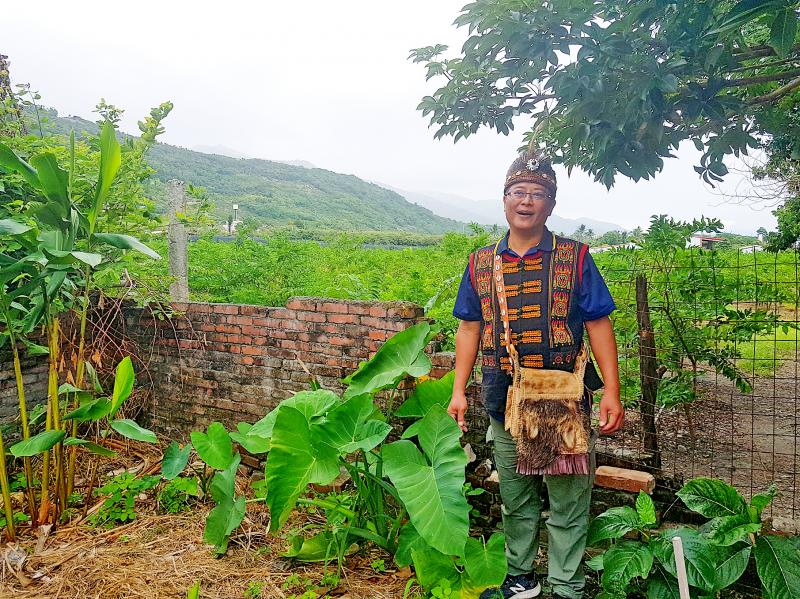
Photo: Noah Buchan, Taipei Times
Other “tourists” asked the officials to sing and dance.
The protest was effective in raising awareness of Aboriginal rights and that the government shouldn’t reduce indigenous communities to a cliche as a means of promoting tourism.
But there is still much work to be done, and current law is not on their side. Although the government has promoted tourism to Aboriginal communities, it is almost next to impossible for them to start and operate their own tourism companies, and therefore control the manner in which they are presented to outsiders. In fact, Robbins says that of the over 3,000 pre-COVID-19 travel companies in Taiwan, only one, Crazy Travel (瘋馬旅遊社), is owned and operated by Aborigines.
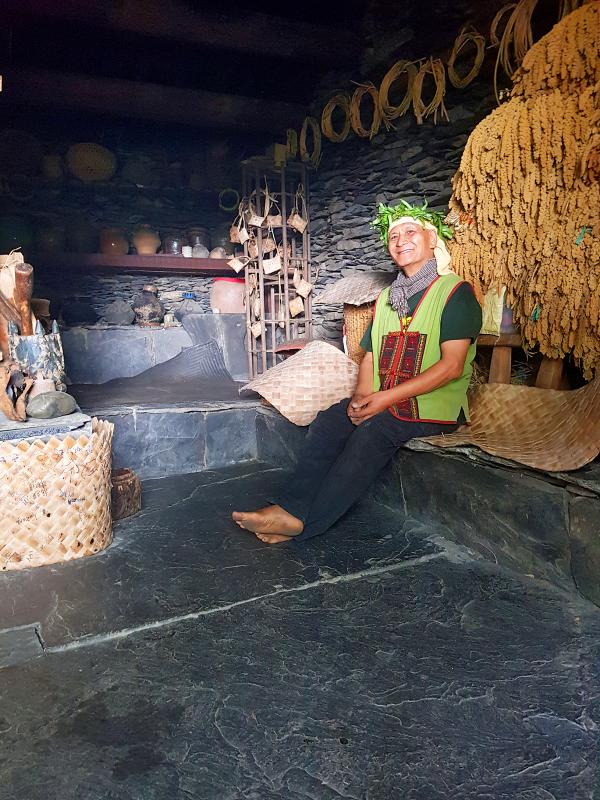
Photo: Noah Buchan, Taipei Times
Robbins says that indigenous communities have been lobbying the Council of Indigenous Peoples to change the law so as to make it easier for them to start their own travel agencies, so far without success.
The law aside, our tour revealed the growing pains that the training program is experiencing — though also where the potential lies.
CHIALAN AND LALAURAN
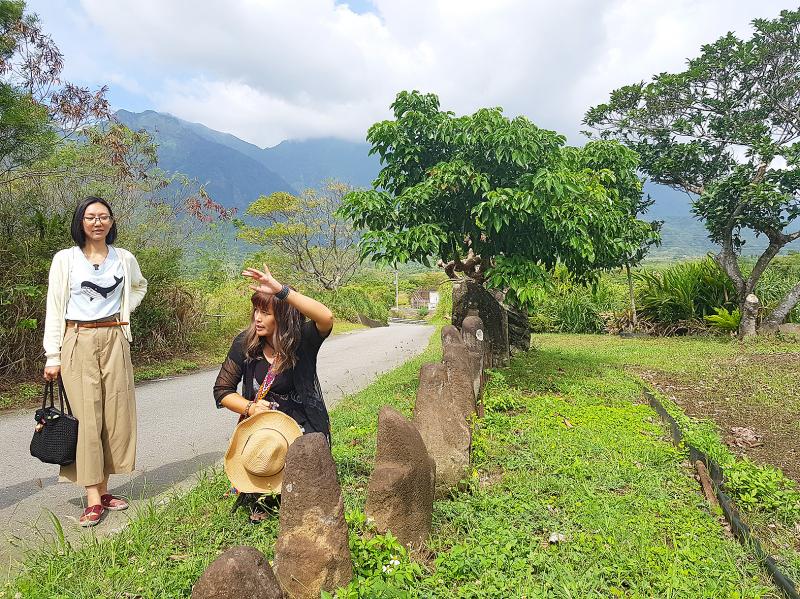
Photo: Noah Buchan, Taipei Times
Before traveling to Sasadre’s slate house, we first visit the Chialan Visitor Center (嘉蘭遊客服務站). Chialan became famous after Typhoon Morakot ravaged the region in 2008 — you’ve probably seen images of houses collapsing into raging rivers.
We are met by Benson Lin (林本森), head of the local Community Development Association, and Drengle, a second-year English-language major at Taitung National University. Together they will introduce their community through eight totems — one for each of the peoples, collectively called the Kaavalan, who were forced to migrate here; Lin in Mandarin, Drengle interpreting.
It starts out well. Lin, through Drengle, talks about how the community moved here from the Jhihben River basin in the 1930s during the Japanese colonial period. As Lin continues his talk, there are fewer and fewer pauses, and he often speaks extemporaneously for a minute or two, an impossible amount of language to interpret unless Drengle is writing it down, which she isn’t. Interpretations like this result:
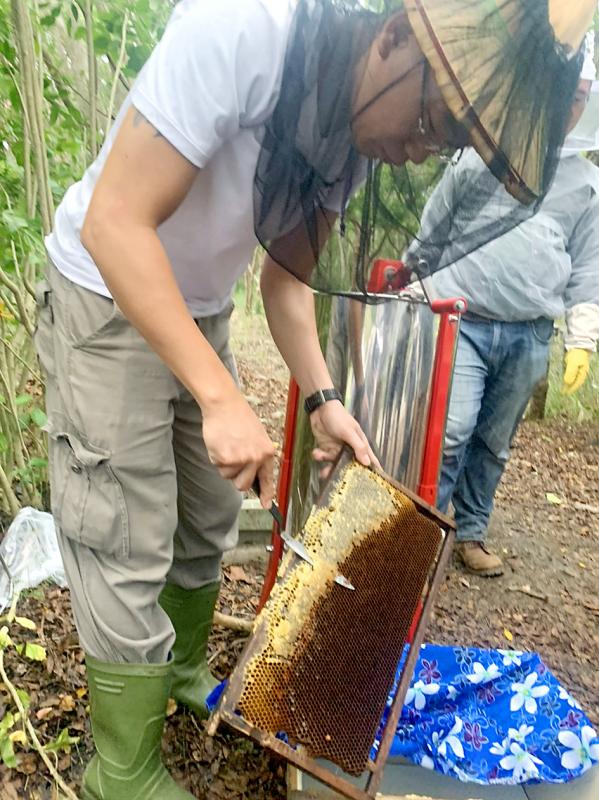
Photo courtesy of Co-create Planning & Design Consultancy
“Other times ... Yup. The important thing is, during the Japanese ruling period, the Japanese government forced them to move to Chialan for easy management and labor. So, the Kaavalan tribe will carry out the smaller tribes to strongest Kaavalan community. Yup.”
When Drengle couldn’t recall all of Lin’s words or stumbled on her own, she always resorted to that endearing “yup.” This may seem like a criticism of Drengle, but it really isn’t. It was her first time interpreting in front of a foreign audience — and Lin wasn’t providing much support. At one point she looked at him with pleading eyes, clearly wanting him to repeat what he had just said. He just looked away. In short, the task required her overcoming significant linguistic and cultural barriers, the latter probably not taught, or even teachable, in her university class. Life experience would have to fill in those blanks.
By the time we reached Sasadre 15 minutes later, Drengle largely gave up any pretext that she was going to provide any interpretation (the non-Taiwanese visitors could largely grasp what was being said). Fortunately, Sasadre kept us enthralled with his detailed explanations and aforementioned antics.
Our stop at the Chialan Community was sandwiched between an early-morning visit to Taimali Township’s (太麻里) Lalauran Millet Workshop (拉勞蘭小米工坊), where we made qavai, a fermented millet-based dumpling from the Paiwan community, with pork, taro stalk and mushrooms that is wrapped in shell ginger leaves. While visiting Chialan, our dumplings would be steamed and served upon our return.
If our visit to the Chialan revealed the difficult task that lays ahead for the program, Jinevungn, our host at Lalauran (“fertile land”), was more scripted in his explanations of his community’s traditions and quite humorous in his delivery, peppering the workshop with anecdotes about where the ingredients are sourced.
Impressed by his fluency in English, I wanted to learn more about the community’s traditions and if he felt a sense of pride by all the interest our group was expressing in the workshop. He couldn’t answer, either because my question was too abstract or he couldn’t use English outside his scripted parts.
And this became a repeated problem. Western travelers often have an interest in the destinations that they travel to and probably don’t require too much of an introduction because they’ve already done research before they visit (hence the huge travel guide industry). With regards to the eight totems outside the Chialan Community Center, there is very little information on the Internet about what they represent, and nothing in English. So having guides that can explain at length their meaning is critical to gaining a deeper understanding of what they represent.
Our afternoon spent at the Miracle of Honey workshop, was overseen by Danny Chiang (江健祺) and an assistant who has a strong command of English. After Chiang gave a powerpoint presentation in English about his Happy Honey Bee Farm (池上樂蜂場), we were given protective clothing and brought to an orchard where there were a few dozen brood boxes with removable frames.
Smoker in hand, Chiang gently removed the frames, swept the bees away from the cone and placed them in another box. We all had a chance to do the same. With the sound of bees buzzing all around, we then brought the frames over to a centrifugal extractor to extract the honey. This enjoyable workshop ended with Chiang pouring the honey into small glass containers, which we could take home.
Curious to know if climate change has had any noticeable impact on bee populations in Taitung, I asked Chiang if he’s noticed an impact on bee habitats. Like Jinevungn before him, he misunderstood my question, replying that in the last few years more and more bee farms have been popping up in Taitung.
Again, this is not meant to be a criticism. Western tourists are going to have questions outside of the scripted bits that are presented. By the end of the first day, I kept wondering: are they going to be able to make this work? Will four years be enough to train interpreters to handle this kind of niche tourism? And then we met Wohay and Yutz Chang (張祐慈) in the Amis community of Changguang (長光).
CHANGGUANG VILLAGE
Changguang is a village of about 200 permanent residents in the northern part of Taitung County, nestled on a plain below soaring mountains and facing the Pacific Ocean. The clear day and gentle wind bode well for this 60-minute jaunt through the history of the Amis community that lives here, colorfully illustrated through various murals of fishers and farmers on a retaining wall that leads into the village.
Wohay, an Amis, will guide the tour and Chang, a Han-Taiwanese, who recently moved here from Yilan to live with her fiancee, Fuyan Suda, pastor of the local Presbyterian church, will interpret.
The walking tour was set up brilliantly, both covering the region’s ancient past and creative present. We learned that the area where this Amis community has lived for a century has been inhabited since the Neolithic period.
Behind a nondescript house and up a nondescript path lies a sarcophagus that archeologists speculate is over 3,000 years old. Another stretch of land, we are told, is scattered with ancient pottery shards, today housed in a community center that is below King Kong Mountain, so-named for its resemblance to the famous gorilla.
At a stop in a ma-and-pop store, where locals come to gossip and talk about the news of the day, we are served an Amis interpretation of three-in-one coffee: Mr. Brown coffee, milk, and the secret ingredient: rice wine. Combined in a pitcher of ice, the beverage had an appealing similarity to Kahlua.
When I asked Chang how much they practiced the tour, she replied that they went over the itinerary twice, and did an on-site mock tour once. It showed. And Chang could handle questions outside of the framework of what she and Wohay had practiced.
As we passed a tree where elders would tell young Amis stories of the community’s past, Chang said that Fuyan Suda’s grandfather had fought in the Pacific campaign for the Japanese in World War II, and recalls American soldiers giving him chocolate when they were liberated — a confection promptly confiscated by Chinese Nationalist Party (KMT) soldiers when he arrived back in Keelung.
When asked about the health of the elderly that frequent the Presbyterian church from Monday to Friday so that they can remain physically and intellectually active, Chang told me that many had hypertension, a health issue that Westerners can certainly relate to.
In short, what Wohay and Chang revealed is that the best interpreters aren’t giving us a literal translation, but using the original words as a starting point to build up a narrative based on a context that the interpreter already has — and this context includes an understanding of what their visitors want or need to know to remain interested in the next bits.
Ultimately, Chang, interpreting Wohay’s words about her Amis community’s history, customs and current practices, gave us a glimpse of what Cross-Generational Bilingual Training Program may possibly achieve over the next four years and beyond, a program that could serve as a model for other Aboriginal communities throughout Taiwan.
As our group left for our next destination, Chang and Wohay told me to return when I have more than 60 minutes, to visit the Presbyterian church, perhaps, or meet some elders who can tell stories of their youth. I certainly will.
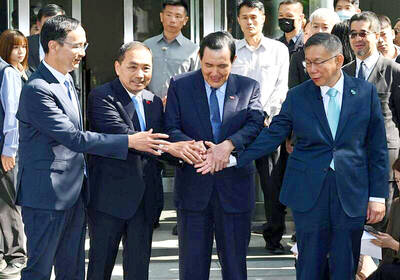
Has the Taiwan People’s Party (TPP) changed under the leadership of Huang Kuo-chang (黃國昌)? In tone and messaging, it obviously has, but this is largely driven by events over the past year. How much is surface noise, and how much is substance? How differently party founder Ko Wen-je (柯文哲) would have handled these events is impossible to determine because the biggest event was Ko’s own arrest on multiple corruption charges and being jailed incommunicado. To understand the similarities and differences that may be evolving in the Huang era, we must first understand Ko’s TPP. ELECTORAL STRATEGY The party’s strategy under Ko was
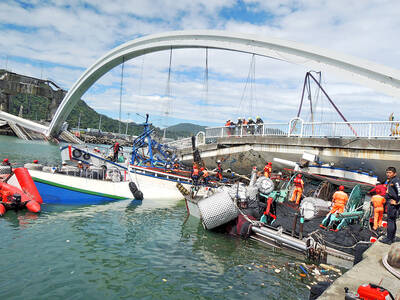
Before the recall election drowned out other news, CNN last month became the latest in a long line of media organs to report on abuses of migrant workers in Taiwan’s fishing fleet. After a brief flare of interest, the news media moved on. The migrant worker issues, however, did not. CNN’s stinging title, “Taiwan is held up as a bastion of liberal values. But migrant workers report abuse, injury and death in its fishing industry,” was widely quoted, including by the Fisheries Agency in its response. It obviously hurt. The Fisheries Agency was not slow to convey a classic government

It’s Aug. 8, Father’s Day in Taiwan. I asked a Chinese chatbot a simple question: “How is Father’s Day celebrated in Taiwan and China?” The answer was as ideological as it was unexpected. The AI said Taiwan is “a region” (地區) and “a province of China” (中國的省份). It then adopted the collective pronoun “we” to praise the holiday in the voice of the “Chinese government,” saying Father’s Day aligns with “core socialist values” of the “Chinese nation.” The chatbot was DeepSeek, the fastest growing app ever to reach 100 million users (in seven days!) and one of the world’s most advanced and
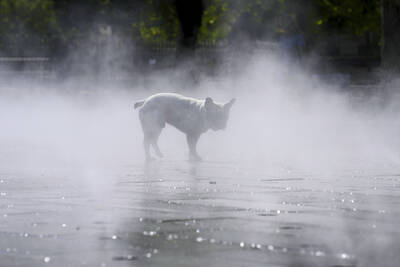
It turns out many Americans aren’t great at identifying which personal decisions contribute most to climate change. A study recently published by the National Academy of Sciences found that when asked to rank actions, such as swapping a car that uses gasoline for an electric one, carpooling or reducing food waste, participants weren’t very accurate when assessing how much those actions contributed to climate change, which is caused mostly by the release of greenhouse gases that happen when fuels like gasoline, oil and coal are burned. “People over-assign impact to actually pretty low-impact actions such as recycling, and underestimate the actual carbon